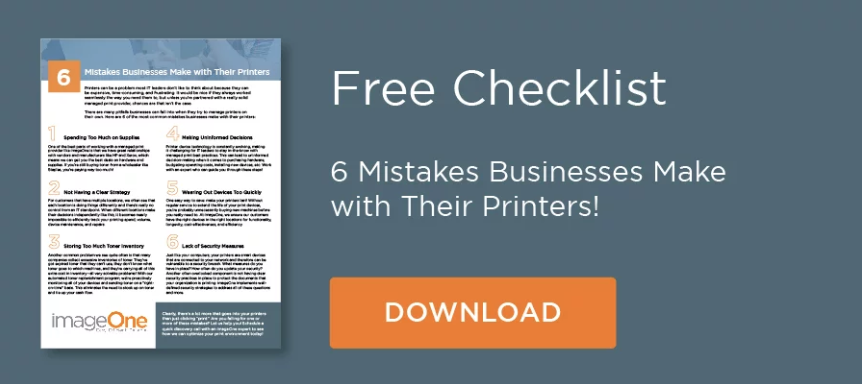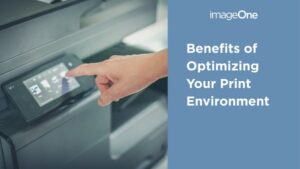Here at imageOne, we’re unapologetically obsessed with everything print. We can also understand why the average person wouldn’t expect many secrets or surprises within our industry.
That’s where they’re wrong.
Most employees overlook the many printer, copier, and paper-related actions we consistently take—and we overlook how these actions affect the bottom line. From print spend to sustainability, check out these eye-opening office printer facts that are both shocking and can save your business money.
1. We Have How Many Printers??
When a managed print service provider meets with a new client, they usually fail answer this question: “How many printers or copiers do you have at your office?”
If they do come up with an estimate, they’re typically about 20–30% away from the actual number—a significant discrepancy, especially for larger companies. It’s an interesting tidbit, but does it really matter?
Absolutely! Spend and security is always a priority, and you can’t measure or monitor devices that you don’t know exists, right?
First off, how can you accurately track, stock, and inventory supplies without a precise device count? By understanding the number of office printers and copier, it’s much easier to see where your money is going. From there, you can better pinpoint how and where to cut expenses.
As for printer security, all it takes is for one unaccounted for—and therefore unsecured—device to get breached. Soon, the entire company is in a panic after a hacker broke in and compromised the entire network.
And considering that a data breach costs the average business over $3.86 million in 2020, you certainly don’t want to take any risks.
2. Ink costs more than Dom Perignon
Since printer ink and toner usually get purchased in tiny amounts, buyers rarely see it in the ranks of the world’s most precious commodities. However, when you start comparing the products ounce by ounce, the price is truly astronomical!
That’s right. Printer cartridge ink costs more than silver, gasoline, and Chanel No. 5! This makes it one of the most expensive liquids on the planet, so you don’t want to waste a drop.
With this in mind, I hope you’re now thinking twice about wasting any valuable ink. Check out this blog for tips on saving money on ink and toner cartridges.
3. Most IT Calls are About Print
Let’s be honest. Printers, scanners, and copiers can be incredibly frustrating. We’ve all had those stress-inducing moments where a big project is due only for the printer to refuse to cooperate.
And it’s in those moments that we typically call on our loyal Help Desk and IT departments in for back-up. In fact, about 40% of all Help Desk tickets involve printers in one way or another.
Every day, the typical office can expect paper jams, error messages, toner replacements, and even critical security breaches! It’s no wonder why print devices often take up over half of the Support Team’s time.
Now, imagine what your IT or Support Team could accomplish if a managed print team alleviated the burden of print maintenance—and this statistic shows just how big of a burden that truly is.
{{cta(‘2002e056-7274-4db6-9db0-e3134e5a5d41′,’justifycenter’)}}
4. 45% of Paper Is Quickly Trashed
On average, just under half of all paper printed from an office’s print device, around 45%, gets discarded by the end of the day. It makes you wonder if any of those pages really needed to be printed at all. Quick mental math can add up those unnecessary paper, ink, and toner costs—not to mention the excessive wear-and-tear on the printer itself.
Waste isn’t only hard on your bottom line. It’s also devastating for the environment. Even if those trashed pages do ultimately make it to the recycling bin, they’re often still destined for a landfill.
Thankfully, there are many ways to maintain, and even exceed, current productivity while significantly decreasing paper waste. Innovative office technology like document automation or programs like PaperCut are easily implemented tools that can make a huge difference fast!
5. One Hard Document Costs $20
Wait. How can a single piece of office paper cost $20?!
Imagine a piece of paper that’s printed out and destined to live as a record or archive. Throughout its lifecycle, it will require space, folders, staples, stamps, and storage. There are also labor costs required to find, organize, and sort each page as it’s shuffled around.
Sure. Most of these costs are minimal, but over time they add up. Costs really rack up when you start accounting for every page within your records or archiving systems.
This is where strategies like document automation or digitization can make an incredible difference. Once digitized, documents can be marked up, passed around, stored, and search for all with the click of a button—and without using up hard resources
Bonus Tip: Get a disaster recovery system and plan in place for your paper documents? The average small-to-medium company would go out of business within three years if their data-filled files were destroyed.
6. You Print 10,000 Pages A Year!
Think our modern offices are using less paper than ever? Think again. Despite the world feeling more digital every day, businesses are relying on hard documents more than ever.
Currently, the average employee uses about 10,000 pages annually—and that number is likely to rise. In 2020, Statista predicts paper use to increase by 1.2%.
7. 1–3% of Revenue Goes To Printers
It’s a number that shocks most IT teams, but it’s true! On average, about 1–3% of the average company’s revenue is spent on print. This makes print the third largest spend outside of rent and payroll.
However, there’s a silver lining to this statistic. Unlike rent, payroll, or other areas where cutting the budget can equate to serious ramifications, with print, it’s relatively easy to start saving money with the right strategies and resources.
8. Managed Print Cuts About 20–30%
Based on a national average, the typical organization can expect to save about 20 to 30% on the hard costs—such as hardware, software, and consumables—associated with print spend by partnering with a managed print service.
Since this percentage only includes the hard cost savings, expect even more benefits tied to the harder to quantify costs like boosted productivity, print quality, enhanced device uptime, and stronger security.
Ready to streamline your office printer environment, cut down on paper, and save money? We’d love to help!
At imageOne, we’re experts at everything from stocking inventory to document automation. Book a free, 15-minute consultation, and one of our MPS providers will show you the way to a better document management experience.
Here at imageOne, we’re unapologetically obsessed with everything print. Connect with me on Twitter and LinkedIn and keep up with my company imageOne. Check out my website or some of my other work here.





